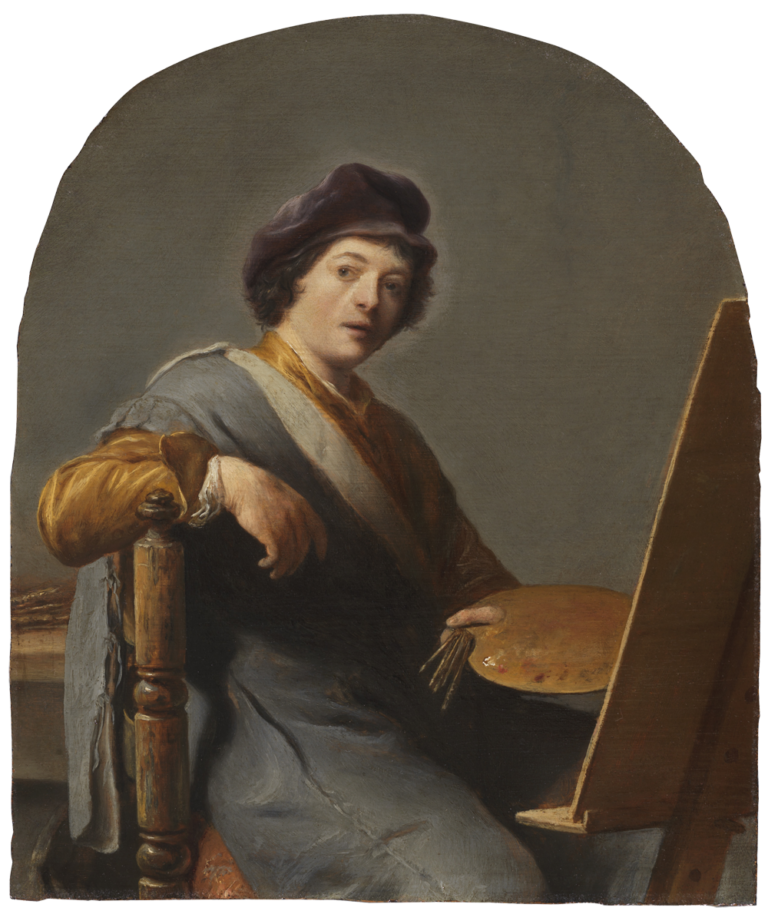Seated before a panel painting resting on his easel, a young painter turns toward the viewer with his arm casually propped on the back of his chair.1 With slightly parted mouth and searching, wide-eyed gaze, the artist is portrayed with an air of immediacy and informality. Except for a small table in the left background, the studio is bare and unadorned, its simplicity evident even in the worn, mottled wood of the artist’s chair. A strong light entering from the left creates sharp highlights on the man’s mustard-colored blouse and violet beret, and illuminates the thin ties of his cyan blue painter’s robe where it hangs over the back of the chair. Although the artist grasps a palette and brushes in his left hand, the viewer has not interrupted his work, as he does not hold a brush in his right hand and the palette is bare except for the small, smudged remnants of white and red pigments.
The attribution of this handsome portrait is a conundrum.2 The painting was once associated with Frans van Mieris the Elder (1635–81), probably because of the panel’s arched format and the smooth and careful rendering of the sitter’s features and clothes. However, most Leiden artists, including Van Mieris and Gerrit Dou (1613–75), added allegorical accoutrements in their self-portraits—lacking here—that served to enhance the artist’s intellectual prestige and social status. For example, Dou’s Self-Portrait from the mid-1630s (fig 1) portrays the artist resting his arm on a plaster cast and situates him in an elegant, curtain-draped interior.3 This artist’s simple dress and the unadorned view of his studio seem entirely different from that pictorial tradition. Closer in character to its half-length composition and informal pose is Judith Leyster’s (1609–60) Self-Portrait of the early 1630s (fig 2). Nevertheless, the clarity of the image and the light tonalities of the palette are characteristic of works produced later in the century. The shape of the artist’s beret and the short cut of his hair are typical of styles from the early 1650s.
Self-portraiture was not confined to artists from Haarlem and Leiden, as can be amply attested by the example of Rembrandt van Rijn (1606–69) during his long career in Amsterdam. As with Rembrandt’s example, attributions of artist self-portraits are often based on the sitter’s appearance, and taking that approach, in this instance, may yield results. Given the young artist’s probable age of around 20–25 years old, one can postulate that he must have been born around 1630. Cornelis Bisschop (1630–74) would appear to be a prime candidate.4 Bisschop was a Dordrecht artist who, according to Arnold Houbraken, studied with Ferdinand Bol (1616–80).5 He spent his entire career in Dordrecht, where he executed portraits, genre subjects and history scenes, but his reputation rested primarily on his illusionistic paintings, often candlelit scenes.6 His fascination with trompe l’oeil illusionism is evident in a self-portrait from 1668 in Dordrecht, depicting him lifting a curtain from a painting, a direct visual association to the ancient painter Parrhasius (fig 3). Parrhasius was renowned for fooling his contemporary Zeuxis by painting a curtain so real that Zeuxis attempted to lift it to view the painting he believed the curtain covered.7
A self-portrait by Bisschop in Detroit executed in the mid-1660s, slightly earlier than the Dordrecht self-portrait, exhibits facial characteristics remarkably similar to those in Self-Portrait of an Artist Seated at an Easel (fig 4).8 In both the Detroit and Leiden Collection paintings, the sitter looks at the viewer with an open expression with his eyebrows arched and his mouth slightly opened. His curly, dark brown hair falls gently to the side of his roundish face. The sitter’s nose is also similarly shaped in each portrait.9 Aside from such similarities in the sitter’s physical appearance, the Leiden Collection painting is executed in a manner that resembles the style of Bisschop’s paintings of the 1660s. For example, the smooth handling of paint and the harmonious balance between ochers and grays in the self-portrait anticipate qualities seen in Bisschop’s Girl Peeling an Apple, 1667, in the Rijksmuseum (fig 5). Unfortunately, not enough is known about Bisschop’s paintings from the 1650s; hence these connections, while intriguing and evocative, are not sufficient to attribute the Leiden Collection painting firmly to this Dordrecht artist.
